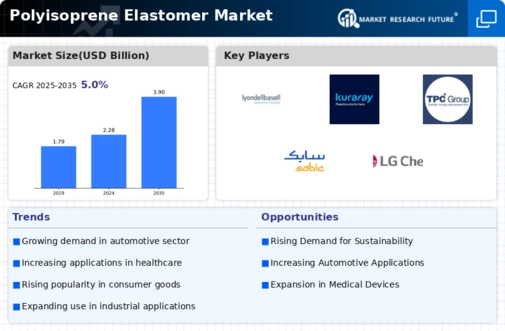Market Growth Projections
Growth in Medical Applications
The Global Polyisoprene Elastomer Market Industry is significantly influenced by the expansion of medical applications. Polyisoprene elastomers are widely used in the production of medical devices, gloves, and catheters due to their biocompatibility and flexibility. The increasing prevalence of chronic diseases and the rising demand for healthcare services are propelling the market forward. As healthcare providers prioritize safety and comfort, the adoption of polyisoprene elastomers is expected to rise. This trend suggests a promising outlook for the industry, with projections indicating a market value of 3.9 USD Billion by 2035, reflecting the material's critical role in healthcare innovation.
Increasing Environmental Awareness
The Global Polyisoprene Elastomer Market Industry is also driven by increasing environmental awareness among consumers and manufacturers. As sustainability becomes a focal point in production processes, the demand for eco-friendly materials is on the rise. Polyisoprene elastomers, derived from renewable resources, present a viable alternative to traditional synthetic rubbers. This shift towards sustainable materials is likely to influence purchasing decisions across various industries, including automotive and consumer goods. Consequently, the market is expected to expand as companies align their product offerings with environmentally responsible practices, thereby enhancing their market position.
Rising Demand in Automotive Sector
The Global Polyisoprene Elastomer Market Industry experiences a notable surge in demand from the automotive sector, driven by the need for lightweight and durable materials. Polyisoprene elastomers are increasingly utilized in manufacturing tires, seals, and gaskets, contributing to enhanced vehicle performance and fuel efficiency. In 2024, the market is projected to reach 2.28 USD Billion, reflecting the automotive industry's shift towards advanced materials. As manufacturers seek to comply with stringent environmental regulations, the adoption of polyisoprene elastomers is likely to grow, indicating a robust growth trajectory in the coming years.
Diverse Applications Across Industries
The Global Polyisoprene Elastomer Market Industry benefits from its diverse applications across multiple sectors, including automotive, medical, and consumer goods. This versatility allows manufacturers to explore various market segments, thereby driving growth. For instance, polyisoprene elastomers are utilized in the production of footwear, adhesives, and coatings, showcasing their adaptability. As industries continue to seek high-performance materials that meet specific requirements, the demand for polyisoprene elastomers is likely to increase. This broad applicability suggests a stable market trajectory, with potential for expansion as new applications are discovered.
Technological Advancements in Production
Technological advancements in the production of polyisoprene elastomers are shaping the Global Polyisoprene Elastomer Market Industry. Innovations in polymerization techniques and processing methods enhance the material's properties, leading to improved performance in various applications. These advancements not only increase production efficiency but also reduce costs, making polyisoprene elastomers more accessible to manufacturers across different sectors. As companies invest in research and development, the market is likely to witness a compound annual growth rate of 4.99% from 2025 to 2035. This growth underscores the importance of continuous innovation in maintaining competitiveness within the industry.
















